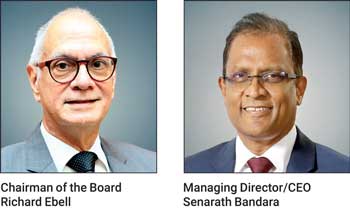- Profit before Income Tax at Rs. 623 m
- Bank maintains strong capital adequacy and liquidity ratios
- Total Capital Ratio at 20.43%
- Statutory Liquid Asset Ratio at 37.72%
- Total Assets grow by 20% or Rs. 11 b
Cargills Bank yesterday announced results for the nine months ended 30 September which reflected continuing QoQ improvement in profitability.
Profit after tax at Rs. 432 million was higher by Rs. 324 million than in the corresponding period of 2022.
“We are pleased the Bank has been able to maintain this momentum of profitability growth and are confident the results of 2023 will reflect the strong commitment of the Banj’s team, successful execution of its strategy, a continued rigorous focus on market trends and its adaptability to a volatile environment,” Cargills Bank said in a statement.
Its Net interest income grew 15% or Rs. 353 million in the nine months compared with the corresponding period of 2022. The Bank directed its resources towards higher yielding assets, hedging interest rate risk and prudently managing deposits. In addition, close monitoring of the Bank’s lending portfolio and timely solutions offered to financially stressed customers helped maintain a healthy NIM to date.
Net fee and commission income of Rs. 590 million for the nine months was lower than the Rs. 641 million in the previous year. The decrease of 6% related largely to lower trade volumes and reduced net income from card related services. Additionally, capital gains realised on derecognition of financial assets, and higher foreign exchange income boosted other income streams by Rs. 265 million, to Rs. 391 million in the nine months.
Total operating expenses increased 25% from Rs. 1.7 billion last year to Rs. 2.1 billion. Personnel expenses increased by 15% largely due to adjustments to salary and welfare benefits considering increased costs of living and market conditions. Other operating expenses grew 44% mainly from the impact of the Social Security Contribution Levy which was effective from October 2022, the increased cost of utilities and the cost of repair and maintenance of IT assets, particularly were denominated in foreign currencies.
Impairment charges totalling Rs. 607 million reflected a reduction of 50% in the first nine months of 2023 evidencing a focused and proactive management of delinquencies and commendable overall team efforts in this direction. The Bank’s Stage 3 Loans (net of Stage 3 impairment) to Total Loans Ratio stood at 6.64% while Stage 3 Provision Cover was 52.74% at 30 September. Additional impairment overlays considered necessary, has been incorporated after a careful scrutiny of the status of borrowers.
VAT on Financial Services and income tax expenses increased substantially mainly due to growth in profits and the increased corporate income tax rate effective from 1 October 2022.
The Bank maintains Capital Adequacy and Liquid Assets Ratios well above the minimum requirements prescribed by the Central Bank. The total Capital Adequacy Ratio was 20.43% while the Statutory Liquid Assets Ratio stood at 37.72%.
Total assets of the Bank on 30 September stood at Rs. 64.7 billion, an increase of 20% or
Rs. 11 billion in the first nine months of the year. Financial Assets measured at fair value through other comprehensive income grew by 92% to reach Rs. 19.6 billion. Positive gains were reflected in other comprehensive income. The loan book registered moderate growth, from Rs. 36.0 billion to Rs. 36.8 billion, given conditions prevailing. In this regard, the Bank exercised care in maintaining the quality of its lending in a high interest rate environment, where interest payments threatened borrowers’ viability. A shift in strategy commenced in the latter part of the period, to rebuild momentum in lending.
Deposits to customers grew 20% from Rs. 37.8 billion at the end of 2022 to Rs. 44.9 billion at the reporting date amidst continued reductions in market interest rates. The Bank will judiciously balance interest expenditure and income, as substantial reductions in interest rates and the time lag in repricing loans have a direct impact on NIMs.
In October, Fitch Ratings affirmed Cargills Bank’s National Long-Term Rating at ‘A(lka)’; Negative Outlook.
Ruvini Fernando, who has served as a Director since 1 August 2018, resigned from the Bank’s Board on 27 October due to personal circumstances. Arjuna Herath has been appointed to the Bank’s Board effective from 1 November.
The Colombo Stock Exchange (CSE) has approved the listing of the Bank’s shares on the CSE. Steps are being taken to duly offer to the public 62.5 million shares of the Bank at Rs. 8 per share through an Initial Public Offering.
“Economic conditions and challenges prevailing last year have moderated somewhat, given the steadfast approach by policy makers and regulatory authorities towards economic recovery. We appreciate their efforts, and our results bear testimony to the progress made. Nevertheless, the road ahead remains challenging. A meaningful Government Budget, continued success of the IMF program, general price stability and regained momentum in tourism, remittances and exports will be key in shaping the country’s short-to medium- term economic revival,” Cargills Bank said.



